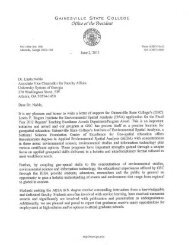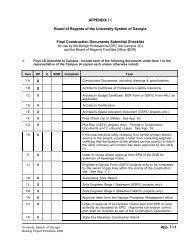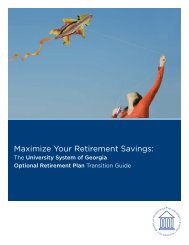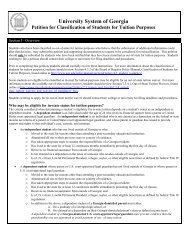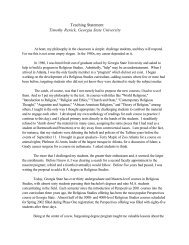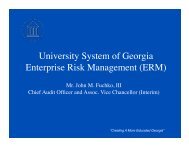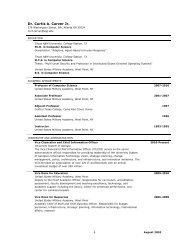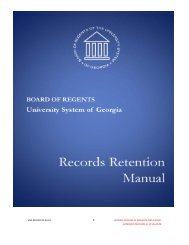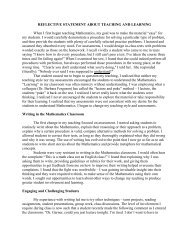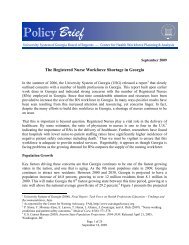66844 Federal Register / Vol. 75, No. 209 / Friday, October 29, 2010 / Rules and RegulationsWReier-Aviles on DSKGBLS3C1PROD with RULES2program within normal time, the typicalcosts for books and supplies (unlessthose costs are included as part <strong>of</strong>tuition and fees), and the amount <strong>of</strong>room and board, if applicable. Theinstitution may include information onother costs, such as transportation andliving expenses, but must provide a Weblink, or access, to the program costinformation it makes available under§ 668.43(a).One-Year ProgramComment: A commenter supportedremoving references to degree programsin proposed § 600.4(a)(4)(iii) believing itwould avoid confusion andmisrepresentation <strong>of</strong> the programssubject to the proposed regulations ongainful employment. Anothercommenter noted that for technicalreasons the <strong>Department</strong> should haveinstead revised § 600.4(a)(4)(i)(C).To better understand which programswould be subject to the reporting anddisclosure requirements in proposed§ 668.6, another commenter asked the<strong>Department</strong> to clarify whether thephrase ‘‘fully transferable to abaccalaureate degree’’ means that everycredit must be transferable to thatdegree.Discussion: A program is fullytransferable to a baccalaureate degree ifit meets the requirements in§ 668.8(b)(1)(ii) and qualifies a studentfor admission into a third year <strong>of</strong> abachelors degree program.We agree that proposed§ 600.4(a)(4)(iii) should be removed inorder to avoid confusion andmisrepresentation <strong>of</strong> the programssubject to the regulations on gainfulemployment. We also agree that§ 600.4(a)(4)(i)(C) should be revised tostate that an institution <strong>of</strong> highereducation provides an educationalprogram that is at least a one academicyear training program that leads to acertificate, or other nondegreerecognized credential, and preparesstudents for gainful employment in arecognized occupation.Changes: Proposed § 600.4(a)(4)(iii)has been removed and § 600.4(a)(4)(i)(C)has been revised as noted in thediscussion above.Definition <strong>of</strong> a Credit Hour (§§ 600.2,602.24, 603.24, and 668.8)GeneralComment: Several commenterssupported the Secretary’s proposeddefinition <strong>of</strong> a credit hour, including acommenter representing institutionalregistrars and admissions <strong>of</strong>ficers. A fewcommenters believed that institutionsare already using this definition. Onecommenter believed that the Secretary’sdefinition aligned with New YorkState’s regulatory definition <strong>of</strong> asemester hour.Discussion: We appreciate the support<strong>of</strong> those commenters who approved <strong>of</strong>the definition <strong>of</strong> a credit hour. Likesome commenters, we believe that manyinstitutions and others, including States,are already following the definition <strong>of</strong> acredit hour or a reasonably comparablestandard that would require minimal orno adjustment for purposes <strong>of</strong>participating in Federal programs.Changes: None.Comment: Several commentersbelieved that during the negotiatedrulemaking process, Federal and non-Federal negotiators reached tentativeagreement on proposed credit-hourregulations that did not include adefinition <strong>of</strong> a credit hour. A fewcommenters believed that during thenegotiated rulemaking process, mostnon-Federal negotiators were opposedto a Federal credit-hour definition.Several <strong>of</strong> these commenters believedthat the <strong>Department</strong> should adhere tothe proposed regulations agreed uponduring the negotiated rulemakingprocess and should remove the credithourdefinition from the regulations.Other commenters believed that theFederal and non-Federal negotiatorsagreed to proposed regulations thatrelied more heavily on accreditingagencies and institutions to determinecredit assignment policies. Thesecommenters believed that the proposedregulations did not appropriately reflectthis position.Discussion: The commenters arecorrect in noting that during thenegotiated rulemaking process tentativeagreement was reached on the proposalrelated to credit hours that did notinclude a definition <strong>of</strong> a credit hour asproposed by the <strong>Department</strong>. Tentativeagreement was reached by removing thedefinition from the proposals to satisfyone non-Federal negotiator. The Federaland non-Federal negotiators tentativelyagreed to proposed credit hourregulations that relied heavily onaccrediting agencies and institutions indetermining the appropriate credithours that represented a student’sacademic work. We also agree with thecommenters who proposed continuingthis reliance to a significant degree, andwe believe that this reliance is reflectedin the final regulations. We note thattentative agreements reached during thenegotiated rulemaking meetings are notbinding on the <strong>Department</strong> in form orsubstance. It is not unusual for most ifnot all <strong>of</strong> the substance <strong>of</strong> a tentativeagreement to be included in a proposedregulation because the <strong>Department</strong> seesVerDate Mar2010 14:10 Oct 28, 2010 Jkt 223001 PO 00000 Frm 00014 Fmt 4701 Sfmt 4700 E:\FR\FM\29OCR2.SGM 29OCR2the benefits that are realized through thediscussion process. In some cases,though, changes may be made uponfurther reflection, or to reinstateconcepts that may have been removedin furtherance <strong>of</strong> an overall consensusthat was not achieved. In the case <strong>of</strong> thedefinition <strong>of</strong> a credit hour wedetermined that the proposed definition<strong>of</strong> a credit hour is necessary to establisha basis for measuring eligibility forFederal funding. This standard measurewill provide increased assurance that acredit hour has the necessaryeducational content to support theamounts <strong>of</strong> Federal funds that areawarded to participants in Federalfunding programs and that students atdifferent institutions are treatedequitably in the awarding <strong>of</strong> thosefunds.Changes: None.Institutional Determination andFlexibilityComment: Many commenters believedthat institutions and accreditingagencies should have the ultimateresponsibility for determining academiccredit. Several commenters believedthat institutions must have thediscretion to use their existing systems<strong>of</strong> self-review and faculty involvementto determine the appropriate credit toassign to academic activities. Some <strong>of</strong>these commenters also believed thatinstitutional processes are solelycapable <strong>of</strong> considering the uniquequalities <strong>of</strong> each class, program,pr<strong>of</strong>essor, and institution. Twocommenters believed that any problemswith credit assignment can be addressedthrough existing institutional reviewprocedures.A few commenters agreed with theprovision in proposed paragraph (3) <strong>of</strong>the credit-hour definition allowinginstitutions to provide reasonable‘‘equivalencies’’ for the amount <strong>of</strong> workspecified in proposed paragraph (1) <strong>of</strong>the definition. Two <strong>of</strong> these commentersbelieved that this provision allowsinstitutions to use alternative methods<strong>of</strong> instruction and measures <strong>of</strong> creditthat are more appropriate forinstitutions with nontraditionalstudents entering the modern workforce.These commenters suggested makingproposed paragraph (3) the firstparagraph in the credit-hour definitionin § 600.2. Another <strong>of</strong> these commentersbelieved that this provision would allowinstitutions the flexibility to use anddevelop innovative forms <strong>of</strong> coursecontent delivery.Several commenters believed that aFederal definition <strong>of</strong> a credit hourwould undermine the integrity <strong>of</strong> theAmerican higher education system
Federal Register / Vol. 75, No. 209 / Friday, October 29, 2010 / Rules and Regulations66845WReier-Aviles on DSKGBLS3C1PROD with RULES2which they believed has been effectiveat assigning credit for over 100 years.One commenter noted that theeducation community has been able toreach consensus on creditdeterminations despite the lack <strong>of</strong> auniform definition.Many commenters believed that credithours are fundamentally measurements<strong>of</strong> academic achievement and othersbelieved that the Secretary’s only reasonfor defining a credit hour is to have astandard measure for determiningeligibility for and distribution <strong>of</strong> title IV,HEA program funds. The commentersbelieved that credit hours should not betreated as fiscal units. One <strong>of</strong> thesecommenters contended that the systems<strong>of</strong> assigning academic credit anddetermining the distribution <strong>of</strong> title IV,HEA program funds are different andshould be kept separate. Anothercommenter expressed concern thattreating credit hours as fiscal unitswould cause the Federal Government togive consideration to fiscal mattersabove all others.Several commenters believed that theSecretary’s proposed definition <strong>of</strong> acredit hour is too restrictive and doesnot account for institutional orprogrammatic variances. Thesecommenters believed that a Federalcredit-hour definition is inapplicable toa diverse educational system composed<strong>of</strong> different types <strong>of</strong> institutions,programs, and course formats.One commenter expressed concernthat the proposed credit-hour definitiondid not account for events that mayoccur within institutions’ academiccalendars, such as Federal and religiousholidays, natural disasters, or campussafety issues. This commenter believedthat these events may prohibitinstitutions’ compliance with proposedparagraph (1) <strong>of</strong> the credit-hourdefinition because institutions may notmeet the requirements for classroominstruction or minimum weeks in asemester.A few commenters believed that theproposed credit-hour definition neededmore specificity in proposed paragraph(1) with regard to the quantity <strong>of</strong> timethat constitutes a credit hour. Onecommenter suggested revising theproposed definition to specifically statethat a credit hour consists <strong>of</strong> 50 minutes<strong>of</strong> instructor contact for every creditearned in a 16 week semester and twohours <strong>of</strong> out-<strong>of</strong>-class work for eachcredit. Another commenter suggesteddefining a credit hour in proposedparagraph (1) <strong>of</strong> the definition in terms<strong>of</strong> clock hours.One commenter suggestedgeneralizing the proposed definition <strong>of</strong>a credit hour to state: (1) A credit houris a unit <strong>of</strong> measure associated with theachievement <strong>of</strong> prescribed learningoutcomes for a particular course <strong>of</strong>study, regardless <strong>of</strong> instructionaldelivery, (2) each institutionparticipating in title IV, HEA programsmust define, document, andconsistently apply its process for thedetermination <strong>of</strong> credit for theachievement <strong>of</strong> learning outcomes, and(3) some institutions may also adhere toa standard academic credit conversionrate as defined by their accreditingagency or State agency.One commenter believed that allaccrediting agencies should be requiredto use a more general definition <strong>of</strong> acredit hour wherein a semester hourconsists <strong>of</strong> at least 15 hours <strong>of</strong> classroomcontact; 30 hours <strong>of</strong> supervisedlaboratory instruction, shop instruction,or documented independent studyactivities; or not fewer than 45 hours <strong>of</strong>externship, internship, or work relatedexperience. This commenter believedthat a quarter hour should consist <strong>of</strong> atleast 10 hours <strong>of</strong> classroom contact; 20hours <strong>of</strong> supervised laboratoryinstruction, shop instruction, ordocumented independent studyactivities; or not fewer than 30 hours <strong>of</strong>externship, internship, or work relatedexperience.One commenter believed that theproposed credit-hour definitionprovided institutions with too muchautonomy to determine an equivalentamount <strong>of</strong> work as defined in proposedparagraph (1) because there are nostandard measures for student learningoutcomes. This commenter suggestedrevising proposed paragraph (1) toequate classroom time with directfaculty instruction and three hours <strong>of</strong>laboratory work with one hour <strong>of</strong>classroom time and two hours <strong>of</strong> out-<strong>of</strong>classwork. The commenter alsosuggested revising proposed paragraphs(2) and (3) to require institutions toestablish and document academicactivities equivalent to the work definedin proposed paragraph (1) and revisingproposed paragraph (3) to requireinstitutions to compare studentachievement to the intended outcomesassigned and student achievementattained for credit hours measuredunder proposed paragraph (1).Discussion: The credit-hour definitionin § 600.2 and the provisions in§§ 602.24(f) and 603.24(c) weredesigned to preserve the integrity <strong>of</strong> thehigher education system by providinginstitutions, accrediting agencies, andState agencies recognized under 34 CFRpart 603 with the responsibility fordetermining the appropriate assignment<strong>of</strong> credit hours to student work. Underproposed §§ 602.24(f) and 603.24(c), theVerDate Mar2010 14:10 Oct 28, 2010 Jkt 223001 PO 00000 Frm 00015 Fmt 4701 Sfmt 4700 E:\FR\FM\29OCR2.SGM 29OCR2institution’s accrediting agency, orrecognized State agency if, in lieu <strong>of</strong>accreditation, the institution isapproved by one <strong>of</strong> the four Stateagencies recognized under 34 CFR part603, would be responsible for reviewingand evaluating the reliability andaccuracy <strong>of</strong> an institution’s assignment<strong>of</strong> credit hours in accordance with thedefinition <strong>of</strong> credit hour in § 600.2.These final regulations employ thesebasic principles <strong>of</strong> reliance oninstitutions and on accrediting agenciesor, if appropriate, recognized Stateagencies, for ensuring institutions’appropriate determinations <strong>of</strong> the credithours applicable to students’coursework.The credit-hour definition in § 600.2is intended to establish a quantifiable,minimum basis for a credit hour that, bylaw, is used in determining eligibilityfor, and the amount <strong>of</strong>, Federal programfunds that a student or institution mayreceive. We believe that the definition <strong>of</strong>a credit hour in § 600.2 is consistentwith general practice, provides for thenecessary flexibilities, and may be usedby institutions in their academicdecision-making processes andaccrediting agencies and recognizedState agencies in their evaluation <strong>of</strong>institutions’ credit assignments.We note, however, that institutions,accrediting agencies recognized under34 CFR part 602, and State agenciesrecognized under 34 CFR part 603 arerequired to use the definition in § 600.2for Federal program purposes such asdetermining institutional eligibility,program eligibility, and studentenrollment status and eligibility. Webelieve that in most instances thedefinition will generally require no orminimal change in institutional practiceto the extent an institution adopts thedefinition for its academic purposesrather than maintaining a separateacademic standard.The provisions in §§ 600.2, 602.24,and 603.24 neither limit nor prescribethe method or manner in whichinstitutions may assign credits to theircourses for academic or other purposesapart from Federal programs. Theseregulations do not require institutions toadopt the definition <strong>of</strong> a credit hour in§ 600.2 in lieu <strong>of</strong> existing institutionalmeasurements <strong>of</strong> academicachievement, but rather to quantifyacademic activity for purposes <strong>of</strong>determining Federal funding. Aninstitution will be able to continueusing the long-standing creditassignmentpractices that it has found tobe most effective for determining credithours or equivalent measures foracademic purposes, so long as it eitherensures conformity, or uses a different
- Page 1 and 2: Friday,October 29, 2010Part IIDepar
- Page 3 and 4: Federal Register / Vol. 75, No. 209
- Page 6 and 7: 66836 Federal Register / Vol. 75, N
- Page 8 and 9: 66838 Federal Register / Vol. 75, N
- Page 10 and 11: WReier-Aviles on DSKGBLS3C1PROD wit
- Page 12 and 13: 66842 Federal Register / Vol. 75, N
- Page 16 and 17: WReier-Aviles on DSKGBLS3C1PROD wit
- Page 18 and 19: 66848 Federal Register / Vol. 75, N
- Page 20 and 21: 66850 Federal Register / Vol. 75, N
- Page 22 and 23: WReier-Aviles on DSKGBLS3C1PROD wit
- Page 24 and 25: 66854 Federal Register / Vol. 75, N
- Page 26 and 27: WReier-Aviles on DSKGBLS3C1PROD wit
- Page 28 and 29: 66858 Federal Register / Vol. 75, N
- Page 30 and 31: 66860 Federal Register / Vol. 75, N
- Page 32 and 33: 66862 Federal Register / Vol. 75, N
- Page 34 and 35: 66864 Federal Register / Vol. 75, N
- Page 36 and 37: 66866 Federal Register / Vol. 75, N
- Page 38 and 39: WReier-Aviles on DSKGBLS3C1PROD wit
- Page 40 and 41: WReier-Aviles on DSKGBLS3C1PROD wit
- Page 42 and 43: 66872 Federal Register / Vol. 75, N
- Page 44 and 45: WReier-Aviles on DSKGBLS3C1PROD wit
- Page 46 and 47: WReier-Aviles on DSKGBLS3C1PROD wit
- Page 48 and 49: WReier-Aviles on DSKGBLS3C1PROD wit
- Page 50 and 51: 66880 Federal Register / Vol. 75, N
- Page 52 and 53: WReier-Aviles on DSKGBLS3C1PROD wit
- Page 54 and 55: 66884 Federal Register / Vol. 75, N
- Page 56 and 57: 66886 Federal Register / Vol. 75, N
- Page 58 and 59: WReier-Aviles on DSKGBLS3C1PROD wit
- Page 60 and 61: WReier-Aviles on DSKGBLS3C1PROD wit
- Page 62 and 63: WReier-Aviles on DSKGBLS3C1PROD wit
- Page 64 and 65:
WReier-Aviles on DSKGBLS3C1PROD wit
- Page 66 and 67:
WReier-Aviles on DSKGBLS3C1PROD wit
- Page 68 and 69:
WReier-Aviles on DSKGBLS3C1PROD wit
- Page 70 and 71:
WReier-Aviles on DSKGBLS3C1PROD wit
- Page 72 and 73:
66902 Federal Register / Vol. 75, N
- Page 74 and 75:
WReier-Aviles on DSKGBLS3C1PROD wit
- Page 76 and 77:
WReier-Aviles on DSKGBLS3C1PROD wit
- Page 78 and 79:
66908 Federal Register / Vol. 75, N
- Page 80 and 81:
WReier-Aviles on DSKGBLS3C1PROD wit
- Page 82 and 83:
66912 Federal Register / Vol. 75, N
- Page 84 and 85:
WReier-Aviles on DSKGBLS3C1PROD wit
- Page 86 and 87:
66916 Federal Register / Vol. 75, N
- Page 88 and 89:
WReier-Aviles on DSKGBLS3C1PROD wit
- Page 90 and 91:
WReier-Aviles on DSKGBLS3C1PROD wit
- Page 92 and 93:
WReier-Aviles on DSKGBLS3C1PROD wit
- Page 94 and 95:
66924 Federal Register / Vol. 75, N
- Page 96 and 97:
WReier-Aviles on DSKGBLS3C1PROD wit
- Page 98 and 99:
66928 Federal Register / Vol. 75, N
- Page 100 and 101:
WReier-Aviles on DSKGBLS3C1PROD wit
- Page 102 and 103:
66932 Federal Register / Vol. 75, N
- Page 104 and 105:
WReier-Aviles on DSKGBLS3C1PROD wit
- Page 106 and 107:
66936 Federal Register / Vol. 75, N
- Page 108 and 109:
66938 Federal Register / Vol. 75, N
- Page 110 and 111:
66940 Federal Register / Vol. 75, N
- Page 112 and 113:
66942 Federal Register / Vol. 75, N
- Page 114 and 115:
66944 Federal Register / Vol. 75, N
- Page 116 and 117:
66946 Federal Register / Vol. 75, N
- Page 118 and 119:
WReier-Aviles on DSKGBLS3C1PROD wit
- Page 120 and 121:
WReier-Aviles on DSKGBLS3C1PROD wit
- Page 122 and 123:
WReier-Aviles on DSKGBLS3C1PROD wit
- Page 124 and 125:
66954 Federal Register / Vol. 75, N
- Page 126 and 127:
WReier-Aviles on DSKGBLS3C1PROD wit
- Page 128 and 129:
66958 Federal Register / Vol. 75, N
- Page 130 and 131:
66960 Federal Register / Vol. 75, N
- Page 132 and 133:
WReier-Aviles on DSKGBLS3C1PROD wit
- Page 134 and 135:
WReier-Aviles on DSKGBLS3C1PROD wit
- Page 136 and 137:
WReier-Aviles on DSKGBLS3C1PROD wit
- Page 138 and 139:
66968 Federal Register / Vol. 75, N
- Page 140 and 141:
66970 Federal Register / Vol. 75, N
- Page 142 and 143:
66972 Federal Register / Vol. 75, N
- Page 144 and 145:
66974 Federal Register / Vol. 75, N



